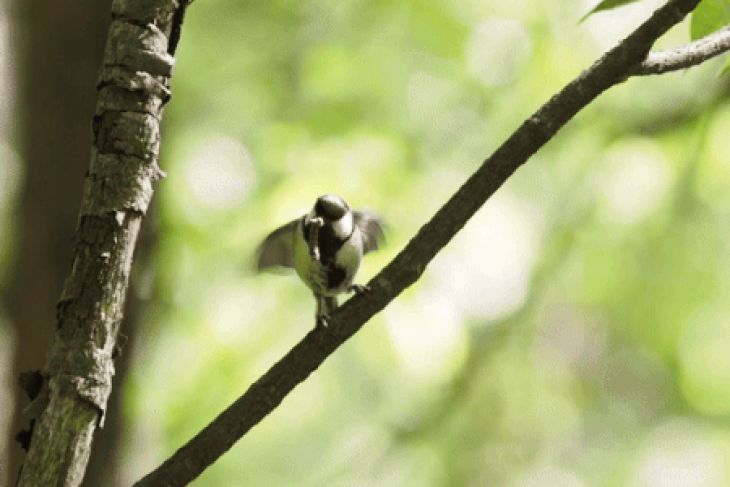
A small-bird species, the Japanese tit (Parus minor), uses wing movements as a gesture to convey the message “after you,” according to new research at the University of Tokyo. When a mating pair arrives at their nest box with food, they will wait outside on perches. One will then often flutter its wings toward the other, apparently indicating for the latter to enter first. The researchers say that this discovery challenges the previous belief that gestural communication is prominent only in humans and great apes, significantly advancing our understanding of visual communication in birds.
A thumbs up, waving goodbye or pointing out a book on a shelf. These gestures and many more are an integral part of how we communicate. Such gestures were once thought to be used exclusively by humans, until closer observations of great apes, such as chimpanzees and bonobos, revealed that they too move their bodies to communicate nonverbally. In more recent years, studies on other animals, such as ravens and fish, have shown that they also use some simple gestures to, for example, point out objects or show something of interest, called deictic gesturing. However, symbolic gestures, such as showing an open hand to signal “after you,” require complex cognitive skills, and there was no conclusive evidence supporting the existence of such abilities in animals other than humans.
Researchers at the University of Tokyo were therefore surprised to find clear evidence of symbolic gesture use by a small wild bird, the Japanese tit. “In our latest discovery, we revealed that the Japanese tit uses gestures to communicate with their mate,” said Associate Professor Toshitaka Suzuki from the University of Tokyo. “For over 17 years, I have been engaged in the study of these fascinating birds. They not only use specific calls to convey particular meanings, but also combine different calls into phrases using syntactic rules. These diverse vocalizations led me to initiate this research into their potential use of physical gestures.”
In spring, Japanese tits form mating pairs and build their nest inside a tree cavity with a small entrance. Suzuki and his co-researcher, Norimasa Sugita, also from the University of Tokyo, observed the behavior of 16 parent birds (eight pairs) breeding in nest boxes. When feeding their nestlings, the birds enter the nest one at a time. The researchers noticed that when carrying food back to the nest, the birds would often find a perch nearby first and then one would flutter their wings toward the other. By analyzing over 320 nest visitations in detail, the researchers saw that the wing-fluttering display prompted the mate who was being fluttered at to enter the nest box first, while the one who fluttered entered second, determining the order of nest entry and mirroring the “after you” gesture observed in human communication.

“We were surprised to find that the results were much clearer than we had expected. We observed that Japanese tits flutter their wings exclusively in the presence of their mate, and upon witnessing this behavior, the mate almost always entered the nest box first,” explained Suzuki. The gesture was performed more often by the female birds, after which the male usually entered the nest box, regardless of which had arrived first. If the female didn’t flutter her wings, then she usually entered the nest box before the male.
The researchers believe this behavior fulfills the criteria to be classified as a symbolic gesture because it only occurred in the presence of a mate, it stopped after the mate entered the nest box and it encouraged the mate to enter the nest box without any physical contact. They also noted that the wing-fluttering “after-you” gesture was aimed at the mate and not the nest box, meaning that it wasn’t being used as a deictic gesture to indicate the position of something of interest.
“There is a hypothesis that walking on two legs allowed humans to maintain an upright posture, freeing up their hands for greater mobility, which in turn contributed to the evolution of gestures. Similarly, when birds perch on branches, their wings become free, which we think may facilitate the development of gestural communication,” said Suzuki. “We will continue to decipher what birds are talking about through gestures, vocalizations and their combinations. This endeavor not only enables us to uncover the rich world of animal languages, but also serves as a crucial key to unraveling the origins and evolution of our own language.”














